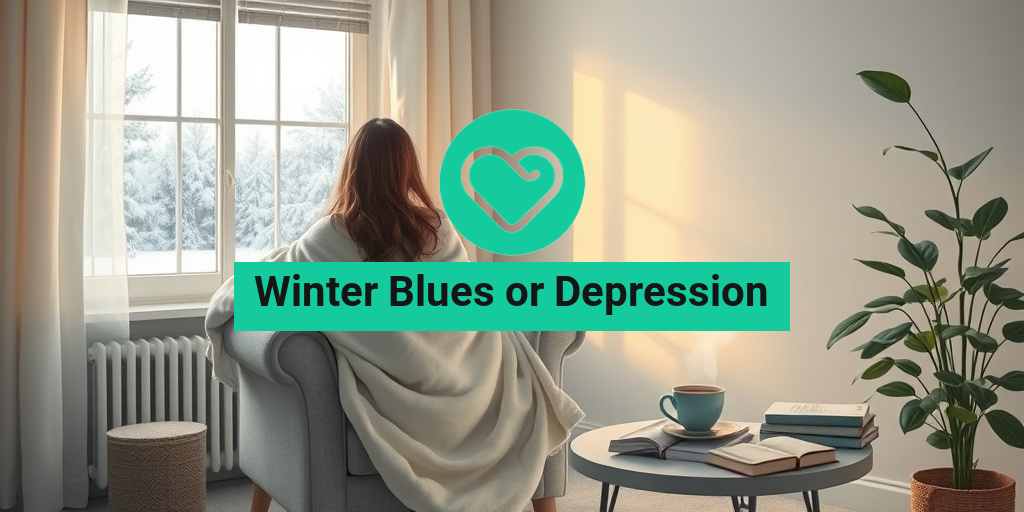What Are Winter Blues?
The term winter blues refers to a seasonal pattern of mood changes that many people experience during the colder months. While it’s common to feel a bit down when the days are shorter and the weather is drearier, for some, these feelings can escalate into a more serious condition known as Seasonal Affective Disorder (SAD). Understanding the winter blues is crucial for recognizing when it’s time to seek help.
Winter blues typically manifest as feelings of sadness, lethargy, and a general lack of motivation. These feelings often arise as the sunlight diminishes, leading to changes in our circadian rhythms and serotonin levels. The lack of natural light can disrupt our internal body clock, making it harder to maintain a positive mood.
Winter Blues vs. Depression
It’s important to differentiate between the winter blues and clinical depression. While both conditions share similar symptoms, the winter blues are usually temporary and tied to seasonal changes. In contrast, depression is a more persistent condition that can occur year-round and often requires professional treatment.
Understanding this distinction can help individuals recognize their feelings and determine whether they need to seek support. If you find that your mood significantly impacts your daily life, it may be time to consult a healthcare professional.
Symptoms of Winter Blues
Recognizing the symptoms of winter blues is essential for addressing them effectively. Here are some common signs to look out for:
- Low Energy: Feeling unusually tired or sluggish, even after a full night’s sleep.
- Changes in Sleep Patterns: Experiencing insomnia or oversleeping can be a significant indicator.
- Increased Appetite: Many people crave carbohydrates and comfort foods during this time.
- Difficulty Concentrating: Struggling to focus on tasks or feeling mentally foggy.
- Loss of Interest: A noticeable decrease in interest in activities you once enjoyed.
- Social Withdrawal: Feeling less inclined to engage with friends and family.
If you notice these symptoms persisting for several weeks, it may be beneficial to explore options for support. Resources like Yesil Health AI (yesilhealth.com) can provide evidence-based health answers and guidance on managing your mental health during the winter months.
When to Seek Help
While the winter blues can be a common experience, it’s crucial to know when to seek help. If your symptoms are severe, last for an extended period, or interfere with your daily life, consider reaching out to a mental health professional. They can help determine whether you are experiencing winter blues, SAD, or another form of depression.
In conclusion, understanding the winter blues or depression is vital for maintaining mental well-being during the colder months. By recognizing the symptoms and knowing when to seek help, you can take proactive steps to improve your mood and overall health. Remember, you’re not alone in this journey, and there are resources available to support you! 🌟

Causes of Seasonal Depression
Seasonal depression, often referred to as the winter blues, is a type of depression that typically occurs during the colder months when daylight hours are shorter. Understanding the causes of this condition can help individuals recognize its symptoms and seek appropriate help. Here are some of the primary factors contributing to seasonal depression:
1. Reduced Sunlight Exposure
One of the most significant causes of winter blues is the lack of sunlight during the winter months. Sunlight plays a crucial role in regulating our body’s internal clock, or circadian rhythm, which affects sleep patterns, mood, and overall well-being. When daylight decreases, it can lead to:
- Disruption of Melatonin Production: Melatonin is a hormone that regulates sleep. Reduced sunlight can increase melatonin levels, leading to feelings of lethargy and sadness.
- Lower Serotonin Levels: Sunlight exposure boosts serotonin, a neurotransmitter that contributes to feelings of happiness. Less sunlight can result in lower serotonin levels, which may trigger depressive symptoms.
2. Biological Factors
Genetics and biology also play a role in seasonal depression. Individuals with a family history of depression or other mood disorders may be more susceptible to experiencing winter blues. Additionally, certain biological factors can contribute to the onset of seasonal depression:
- Hormonal Changes: Fluctuations in hormones during the winter months can affect mood and emotional stability.
- Vitamin D Deficiency: Reduced sunlight exposure can lead to lower levels of vitamin D, which is linked to mood regulation.
3. Psychological Factors
Psychological factors can also contribute to the development of seasonal depression. These may include:
- Negative Thought Patterns: Individuals prone to negative thinking may find it harder to cope with the winter months, leading to feelings of hopelessness.
- Stress and Anxiety: Increased stress levels during the holiday season or winter months can exacerbate feelings of depression.
4. Lifestyle Factors
Our lifestyle choices can significantly impact our mental health. During the winter, people may be less active and more isolated, which can contribute to feelings of sadness. Some lifestyle factors include:
- Decreased Physical Activity: Cold weather often discourages outdoor activities, leading to a more sedentary lifestyle.
- Social Isolation: The winter months can lead to reduced social interactions, which are vital for emotional support and well-being.
Risk Factors for Winter Blues
While anyone can experience the winter blues, certain individuals may be at a higher risk. Understanding these risk factors can help in identifying those who may need additional support during the colder months.
1. Geographic Location
People living in northern latitudes, where winter days are significantly shorter, are more likely to experience seasonal depression. The lack of sunlight in these regions can lead to a higher prevalence of winter blues.
2. Age and Gender
Research indicates that younger individuals and women are more likely to experience seasonal depression. Women are diagnosed with seasonal affective disorder (SAD) at a rate of about four times higher than men, although men may experience more severe symptoms.
3. Family History
A family history of mood disorders can increase the likelihood of experiencing winter blues. If a close relative has struggled with depression, it may heighten your risk as well.
4. Pre-existing Mental Health Conditions
Individuals with a history of depression, anxiety, or other mental health disorders are at a greater risk for developing seasonal depression. The winter months can exacerbate existing conditions, making it essential to monitor mental health closely during this time.
5. Lifestyle Choices
Unhealthy lifestyle choices, such as poor diet, lack of exercise, and inadequate sleep, can increase the risk of winter blues. Maintaining a balanced lifestyle is crucial for mental health, especially during the winter months.
Recognizing the causes and risk factors associated with winter blues or depression is the first step toward managing this condition effectively. If you or someone you know is struggling, seeking professional help can make a significant difference. 🌟
![]()
Diagnosis of Seasonal Affective Disorder
Seasonal Affective Disorder (SAD), often referred to as the winter blues, is a type of depression that occurs at a specific time of year, usually in the fall and winter months. Understanding how to diagnose this condition is crucial for effective treatment. Here’s what you need to know.
Recognizing the Symptoms
The symptoms of SAD can vary from person to person, but common signs include:
- Persistent sadness or low mood
- Loss of interest in activities once enjoyed
- Changes in sleep patterns, such as oversleeping or insomnia
- Weight gain or changes in appetite
- Difficulty concentrating or making decisions
- Feelings of hopelessness or worthlessness
If you notice these symptoms occurring during the winter months and improving in the spring, it may indicate SAD rather than general depression. 🌨️
Consulting a Professional
To receive a proper diagnosis, it’s essential to consult a healthcare professional. They may use the following methods:
- Clinical Interview: A thorough discussion about your symptoms, medical history, and family history of mood disorders.
- Diagnostic Criteria: Healthcare providers often refer to the DSM-5 (Diagnostic and Statistical Manual of Mental Disorders) to determine if you meet the criteria for SAD.
- Physical Examination: Sometimes, a physical exam or lab tests are conducted to rule out other medical conditions that may mimic SAD symptoms.
It’s important to note that while the winter blues can feel overwhelming, they are treatable. Early diagnosis can lead to more effective management of symptoms.
Effective Treatments for Winter Blues
Once diagnosed with Seasonal Affective Disorder, various treatment options can help alleviate symptoms and improve your quality of life. Here are some effective treatments to consider:
Light Therapy
One of the most common treatments for SAD is light therapy. This involves sitting in front of a specially designed light box that mimics natural sunlight. Here’s how it works:
- Daily Sessions: Typically, you’ll need to spend about 20-30 minutes each day in front of the light box, preferably in the morning.
- Boosts Serotonin: Exposure to bright light can help increase serotonin levels, which can improve mood and alleviate symptoms of depression.
Many people find significant relief from their symptoms through this method. ☀️
Psychotherapy
Another effective treatment for the winter blues is psychotherapy, particularly cognitive-behavioral therapy (CBT). This approach helps individuals:
- Identify Negative Thoughts: Recognize and challenge negative thought patterns that contribute to feelings of sadness.
- Develop Coping Strategies: Learn practical skills to manage stress and improve emotional resilience.
Working with a therapist can provide valuable support and guidance during the winter months.
Medication
In some cases, medication may be necessary to manage symptoms of SAD. Antidepressants, particularly selective serotonin reuptake inhibitors (SSRIs), can be effective. Here’s what to consider:
- Consultation Required: Always consult with a healthcare provider to determine if medication is appropriate for you.
- Monitor Side Effects: Be aware of potential side effects and communicate with your doctor about any concerns.
Lifestyle Changes
Incorporating certain lifestyle changes can also help combat the winter blues. Consider the following:
- Regular Exercise: Physical activity can boost endorphins and improve mood.
- Healthy Diet: Eating a balanced diet rich in fruits, vegetables, and whole grains can support overall mental health.
- Social Connections: Stay connected with friends and family, as social support is vital during challenging times.
By combining these treatments and lifestyle changes, individuals can effectively manage their symptoms and enjoy a more fulfilling winter season. ❄️

Home Remedies for Seasonal Depression
As the days grow shorter and the temperatures drop, many individuals experience a shift in their mood, often referred to as winter blues or depression. This seasonal affective disorder (SAD) can leave you feeling lethargic, irritable, and unmotivated. Fortunately, there are several effective home remedies that can help alleviate these symptoms and boost your mood during the colder months.
1. Get Plenty of Natural Light
One of the most effective ways to combat the winter blues is to increase your exposure to natural light. Sunlight helps regulate your body’s internal clock and can improve your mood. Here are some tips:
- Open your curtains during the day to let in as much sunlight as possible.
- Consider using a light therapy box, which mimics natural sunlight and can be particularly helpful during the darker months.
- Spend time outdoors, even on cloudy days, to soak up whatever light is available.
2. Stay Active
Physical activity is a powerful tool against depression. Regular exercise releases endorphins, which are natural mood lifters. Here are some ways to incorporate more movement into your day:
- Take brisk walks outside, even if it’s chilly. Dress warmly and enjoy the fresh air! 🌬️
- Join a local gym or fitness class to stay motivated and meet new people.
- Try indoor activities like yoga or dance to keep your spirits high.
3. Maintain a Healthy Diet
Your diet plays a crucial role in your mental health. Eating a balanced diet rich in nutrients can help combat the winter blues or depression. Focus on:
- Fruits and vegetables, which are high in vitamins and antioxidants.
- Whole grains, which provide sustained energy and can help stabilize your mood.
- Omega-3 fatty acids found in fish, walnuts, and flaxseeds, known for their mood-boosting properties.
4. Stay Connected
Isolation can exacerbate feelings of sadness and depression. Make an effort to stay connected with friends and family. Here are some ideas:
- Schedule regular video calls or phone chats with loved ones.
- Join community groups or clubs that interest you to meet new people.
- Volunteer for local organizations to give back and connect with others.
5. Practice Mindfulness and Relaxation Techniques
Mindfulness practices can help you stay grounded and reduce feelings of anxiety and depression. Consider incorporating the following into your routine:
- Meditation: Spend a few minutes each day focusing on your breath and clearing your mind.
- Deep breathing exercises: These can help calm your nervous system and reduce stress.
- Journaling: Write down your thoughts and feelings to process your emotions better.
Tips for Coping with Winter Blues
Dealing with the winter blues vs depression can be challenging, but there are practical strategies you can implement to help manage your mood and maintain a positive outlook. Here are some effective tips:
1. Establish a Routine
Creating a daily routine can provide structure and stability, which is especially important during the winter months. Try to:
- Wake up and go to bed at the same time each day.
- Plan your meals and exercise sessions to ensure you stay on track.
- Include enjoyable activities in your schedule to give you something to look forward to.
2. Limit Alcohol and Caffeine
While it might be tempting to indulge in warm drinks during the winter, excessive alcohol and caffeine can negatively impact your mood. Instead, try:
- Opting for herbal teas or decaffeinated beverages.
- Staying hydrated with water to help maintain your energy levels.
3. Seek Professional Help if Needed
If your symptoms persist or worsen, it may be time to seek professional help. A mental health professional can provide support and guidance tailored to your needs. Remember, it’s okay to ask for help! 🤝
4. Embrace the Season
Instead of dreading the winter months, try to embrace the unique aspects of the season. Engage in winter activities such as:
- Ice skating or skiing for some outdoor fun.
- Cozying up with a good book or movie on cold nights.
- Decorating your home to create a warm and inviting atmosphere.
By implementing these home remedies and coping strategies, you can effectively manage the winter blues or depression and enjoy the beauty of the season. Remember, you are not alone in this journey, and there are many resources available to support you! 🌟

Frequently Asked Questions about Winter Blues or Depression
What are the symptoms of Winter Blues or Depression? 🌨️
The symptoms of winter blues or depression can vary from person to person, but common signs include:
- Persistent sadness or low mood
- Fatigue or low energy
- Changes in sleep patterns (insomnia or oversleeping)
- Difficulty concentrating
- Loss of interest in activities once enjoyed
- Changes in appetite or weight
How can I differentiate between Winter Blues and Depression? 🤔
While both winter blues and depression share similar symptoms, the key difference lies in their duration and intensity. Winter blues typically occur during the colder months and may resolve with the arrival of spring. In contrast, depression is a more persistent condition that can last for months or even years without treatment.
Are there any statistics on Winter Blues? 📊
Yes, studies indicate that a significant number of people experience winter blues. Approximately 10-20% of individuals living in colder climates report symptoms related to this seasonal affective disorder. Awareness of these statistics can help in recognizing the prevalence of this condition.
What are some effective treatments for Winter Blues? 💡
There are several effective treatments for winter blues or depression, including:
- Light therapy: Exposure to bright light can help alleviate symptoms.
- Regular exercise: Physical activity can boost mood and energy levels.
- Healthy diet: Eating a balanced diet can improve overall well-being.
- Social support: Connecting with friends and family can provide emotional support.
- Professional help: Consulting a therapist or counselor can be beneficial.
Can Winter Blues lead to more serious depression? ⚠️
Yes, if left untreated, winter blues can potentially develop into more serious forms of depression. It is important to seek help if symptoms persist or worsen over time.
What lifestyle changes can help combat Winter Blues? 🌱
Making certain lifestyle changes can significantly help in managing winter blues or depression. Consider the following:
- Establishing a regular sleep schedule
- Engaging in outdoor activities, even in winter
- Practicing mindfulness or meditation
- Setting realistic goals and expectations
Is there a difference between Winter Blues and feeling sad? 😞
Yes, while feeling sad is a normal human emotion, winter blues refers to a specific set of symptoms that occur during the winter months. It is more intense and can affect daily functioning, whereas sadness may be temporary and situational.




